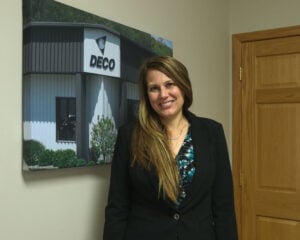Any injection molded parts, such as high pressure die castings, will have to deal with a “parting line”. In diecasting, the cavity is formed by a metal die or mold, typically split into two halves. Molten metal is rapidly forced into the mold and rapidly cools. Then the two halves of the mold separate and the part is ejected. This technique leaves a line formed where the two halves of the mold meet, and open to release the part.
Our engineers and your engineers can collaborate to determine which surface is the best place to have the two mold halves meet.
According to Jim Myers, Design Engineer at Deco Products, the parting line follows the outer periphery of the part geometry. “It’s like taking a photograph of the part’s outline,” he explains. The goal is to place that line where the mold can separate cleanly.
Functional Design Considerations
Designing an effective parting surface involves a careful examination of the part. It also requires considering where the steel mold may end up with a fragile or thin section of steel. Additionally, our engineers need to consider how cores and slides will interact with the other features of the tool in the overall mold design. Planning the location of the parting line strategically ensures that the cavity in the mold’s ejector half can effectively release the part to maximize production quality and the lifespan of the tool.
Minimizing Flash and Cost
Flash forms when molten zinc escapes between the two mold halves. The more complex the parting surface, the greater the risk of flash.
“We strive to keep the parting line as flat as possible,” says Myers. Flat surfaces reduce flash and simplify trimming. Reducing corner radii can also help flatten the parting area. Step parting lines, where the mold changes elevation, are sometimes necessary but increase the chance of flash.
A flat split line enhances the part’s aesthetics, drastically reducing the changes of flash. Simultaneously, it diminishes the necessity for extra operations, such as trimming, leading to cost reductions.
Our engineers aim to keep the parting surface as flat as possible, reducing the chance of flash occurrence. Achieving this involves identifying potential corner breaks on the casting and recommending reduced radii for a flatter parting line. Our engineers are experts at this review and happy to support your design team to design a better casting.

Step Parting Lines
Although we want to avoid them, step parting lines are necessary to accommodate complex geometries with varying elevations. However, step parting lines increase the potential for flash formation.
Design engineers must carefully analyze the stepped areas. They strive to keep the design as simple as possible to minimize flash. While trim dies can aid in flash removal, they may not be completely effective because the draft on the casting. Therefore, minimizing the complexity of parting surface remains crucial.
Parting Line Design and Cost
Efficient parting line design plays a vital role in the overall production process. A well-designed parting line ensures smooth mold opening and closing, reducing cycle times and enhancing productivity. Additionally, it facilitates the proper ejection of the part, preventing damage and ensuring dimensional accuracy.
“What we strive to do when designing parting lines for the dies is try to keep it as simple as possible.” Jim Myers, Design Engineer at Deco Products
Conclusion:
Parting lines are a fundamental aspect of the die-casting process. They enable the extraction of cast parts from the mold. Additionally, they play a significant role in minimizing defects and production costs.
By strategically designing parting lines, considering material properties, and aiming for simplicity, manufacturers can achieve high-quality die-cast parts efficiently. Understanding the types of parting line empowers designers and engineers to optimize the die cast components. This empowerment leads to the delivery of exceptional products.
Design and Engineering at Deco Products

Michele Duwe
Michele Duwe is the Sales and Marketing Manager with Deco Products. She has eight plus years as a digital marketing manager and over a decade of sales and marketing experience.

